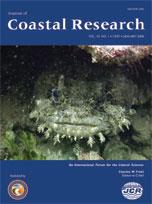On the coast of Kerala, southwest India, oceanographic measurements were made at the beach, in the surf zone region, and on the inner shelf and then were combined with mechanism-focussed numerical modelling. The goal was to investigate the sedimentary dynamics of an open coast monsoonal beach. A closed sedimentary circulatory system (here described as a “step-ladder”) was identified. Strong annual cycles were observed in waves, winds, and currents. Regional-scale dynamic sediment equilibrium is maintained by an annual net northerly sediment flux in the near-shore, driven by wave-induced currents. This is balanced by a net southerly flux on the inner shelf, but driven instead by wind-induced currents that transport the wave-induced suspended sediment. The two counterdirectional sedimentary pathways are linked by cross-shore bridging transport. A clear association between the annual beach erosion and accretion patterns and the cross-shore direction of the near-bed bridging currents on the inner shelf was recorded and was associated with seasonal and shorter oscillations in the cross-shore component of wind, leading to inner shelf downwelling during the onshore wind periods and upwelling at other times. This occurs in synchrony with wave-induced beach erosion during the stormy onshore wind periods and accretion during the periods of narrow-banded swell and offshore winds, thereby delivering the sediment to or from the beach to be further transported on/offshore by shelf currents. Overall, the synchronous and supportive behaviour of the physical factors results in an unusual sedimentary equilibrium that explains how a strong net littoral drift can be sustained when supplies of nearshore feeder sands are absent.
How to translate text using browser tools
1 January 2008
Open Coast Monsoonal Beach Dynamics
K. P. Black,
N. P. Kurian,
J. Mathew,
M. Baba
ACCESS THE FULL ARTICLE

Journal of Coastal Research
Vol. 2008 • No. 241
January 2008
Vol. 2008 • No. 241
January 2008
beach erosion
Beach profiles
black sand
cross-shore sediment transport
hydrodynamic
Longshore sediment transport
sediment transport modelling




